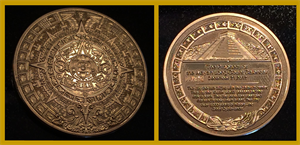 Maya Calendar Geocoin
Maya Calendar Geocoin
| Trackable Options |
 Found this item? Log in.
Found this item? Log in. |
 Printable information sheet to attach to Maya Calendar Geocoin
Print Info Sheet
Printable information sheet to attach to Maya Calendar Geocoin
Print Info Sheet |
| There is 1 user watching this listing. |
-
Owner:
-
omham108
Message this owner
-
Released:
-
Saturday, August 28, 2010
-
Origin:
-
Washington, United States
-
Recently Spotted:
-
In the hands of the owner.
This is collectible.
Use TB3E2BD to reference this item.
First time logging a Trackable? Click here.
FOR DISCOVERY ONLY PLEASE
We request this to be left inside the geocache container to be found at A New Era [GC3XRGX] to be DISCOVERED as part of the prize for the completion of the Maya Temple puzzle caches and successful computation of all the Mayan number symbols needed to solve that Challenge Mystery Geocache.
Soon after the original geocoin was released, it was taken as a normal trackable. Then we got it back and made the proxy with a photo that is now back in the geocache container. That was also taken as a normal trackable. So you'll see in the logs that it has had quite a journey until its return to us in May of 2020. Thanks to a geocacher who found this at an Orlando travel bug hotel and mailed it back to me.

The metal coin shown in the photo was purchased so we could give it a tracking number and make it a geocoin to be associated with the Temple Series, twenty Mystery Geocaches published each day of the last twenty days of the "long count calendar. The Mystery icons form a geo-art found in Lake Sammamish, Washington. Those geocaches celebrated the Maya people, their culture, and sometimes mocked the end of the world myth related to the end of that calendar.
What is the Maya Calendar?
The "long count" third calendar used by the Maya (that is the basis of all the sensationalist talk in 2012) was not an invention of the Maya. It was used by many cultures in the mesoamerica area. This Wiki article explains more about that: http://en.wikipedia.org/wiki/Mesoamerican_Long_Count_calendar
The Maya used three different calendars. The first was the sacred calendar, or Tzolk'in, which lasted 260 days and then started over again, just as our 365-day calendar refreshes once it hits Dec. 31. This calendar was important for scheduling religious ceremonies. The second calendar was the Haab', or secular calendar, which lasted 365 days but did not account for the extra quarter-day it takes the Earth to revolve around the sun. (The modern calendar accounts for this fraction by adding a day to February every four years, the reason we have leap years.) That means the calendar wandered a bit in relation to the seasons.
The final calendar was the Long Count Calendar — the recording method that has caused all of the doomsday brouhaha of 2012. On Dec. 21 (approximately), the calendar completes a major cycle, which has triggered doomsday fears and mystical rumors about the end of an age.
How the Long Count Calendar Worked:
The Long Count Calendar is best for covering long periods of time. Here's how it works: Dates are written out as five numbers separated by four periods, such as 13.0.0.0.0. (The ancient Maya represented these not with numerals, of course, but with their own hieroglyphs.)
The right-most position is called the k'in, which counts single days: 13.0.0.0.1, for example. The k'in counts up to 19 and then flips back to zero, with counting picked back up by the next position, the uinal. So 13.0.0.0.19 would become 13.0.0.1.0, much like a car odometer.
Each uinal is thus a block of 20 days. The k'in position then picks back up, counting up to that 20, which then gets added to the uinal. So the day after 13.0.0.1.0 would be 13.0.0.1.1 and then 13.0.0.1.2, all the way up to 13.0.0.1.19 and finally 13.0.0.2.0.
The uinals count upward as well. While the Maya generally use a base-20 counting system, Witschey said, they modify this slightly for the uinal, which only counts up to 17 before rolling over to the third position, the tun. Each tun is thus 18 blocks of 20 days, or 360 days — approximately a year by the solar calendar.
Tuns, in turn, count up to 20 before rolling over into k'atuns. As 20 blocks of 360 days, each k'atun translates into 7,200 days, or just less than 20 years. The k'atun place then counts up before rolling over into the final digit, the b'ak'tun.
If that word sounds familiar, it's because Dec. 21, 2012, on our calendar marks the end of the 13th b'ak'tun of the Mayan Long Count Calendar. In other words, it's the day the count will read 13.0.0.0.0. On Dec. 22, it will read 13.0.0.0.1.
Gallery Images related to Maya Calendar Geocoin
View All 6 Gallery Images
Tracking History (77582.2mi) View Map